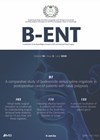
Journal Reviews
Malignant transformation of leukoplakia in previous cancer patients
This is a retrospective study from Taiwan assessing risk factors in developing oral squamous cell carcinoma from surgically excised oral leukoplakia in patients with a previous oral cancer, the underlying thought being that patients with an oral carcinoma have a...
Dysphagia in people with HPV-related oropharyngeal cancer
Human papilloma virus (HPV) associated oropharyngeal cancers are becoming much more prevalent and, in some geographic areas, have overtaken tobacco as the leading cause of oropharyngeal cancer. HPV-associated cancers are also reported to have better prognosis in general, and research...
Clinical pathological features associated with malignant change in oral leukoplakias
This is a retrospective study from Sweden where 234 patients, diagnosed between 2003 and 2013 with a median nine-year follow-up, were reviewed. Of these 234 patients, 11.5% developed oral squamous cell carcinoma. Non-homogenous leukoplakia showed a 15-times higher transformation rate...
Narrow band imaging in the management of carcinoma of unknown primary
This was a retrospective study to assess the utility of narrow band imaging (NBI) in the detection of a primary site in carcinoma of unknown primary (CUP). Patients with CUP who underwent transoral robotic surgery (TORS) and preoperative imaging with...
PET-CT for malignant nasopharyngeal lesions
This retrospective Turkish review of 92 patients aimed to determine the ability of fluorine 18-fluorodeoxyglucose (FDG) maximum standardised uptake value (SUVmax) on positron emission tomography/computerised tomography (PET/CT) to differentiate benign processes and malignant nasopharyngeal lesions. The authors retrospectively reviewed the...
Intraoperative identification of primary tumours in unknown primary head and neck cancer using transoral laser microsurgery with frozen sections
The aim of the study was to compare the sensitivity and specificity of intraoperative identification of primary tumours in patients with unknown primary head and neck squamous cell carcinoma (UP HNSCC) using transoral laser microsurgery (TLM) with frozen sections, with...
Elevated prevalence of late-onset dysphagia among head and neck cancer survivors and identifying risk factors
Dysphagia is one of the most common problems affecting head and neck cancer (HNC) survivors. There are few studies investigating late-onset dysphagia post-treatment. The authors set out to investigate the prevalence of dysphagia-related diagnoses and procedures five years’ post-treatment, changes...
Delays in oral cancer
This is a review from Canada where they attempt to relate delays in oral cancer presentation to treatment and the impact on stage, diagnosis and survival. They recognise that potentially the most significant delay is between the patient first noticing...
Significance of abnormal retropharyngeal nodes in head and neck cancer
Abnormal retropharyngeal lymph nodes (RLN) have prognostic relevance for patients with oral, oropharyngeal or nasopharyngeal squamous cell carcinoma (SCC). However, consensus on the evaluation and management of abnormal RLN in these patients is lacking. The authors of this paper provided...
Is bone scanning still of value?
This is an article from Australia of 109 patients, 83 of which had CT, 72 MRI and the presence of bone invasion on imaging was compared with the histopathology. Bone invasion was present in 44 of 109 resection specimens. Bone...
Sinonasal undifferentiated carcinoma – slowly getting there
The rarest of the rare, sinonasal tumours form only a small part of the total number of head and neck tumours and undifferentiated carcinoma (SNUC) is one of the rarest of this group. There is some data (and some expert...
Investigation of the role of KPNA2 biomarker in oral SCC invasiveness
This edition of Head and Neck has a strong focus on studies using immunohistochemistry (IHC) to elucidate potential roles of various cell-signalling molecules in both HNSCC and thyroid cancer. The ‘cellular-protein heavy’ title of this article may be off-putting to...
















